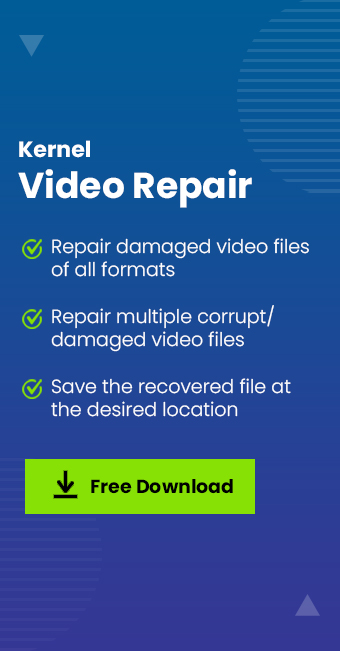Read time 9 minutes
A video is a series of pictures along with audio data. This bundling of images and audio makes a video file much more complex than an image or audio file. It comprises audio-video signals, containers, and codecs. You may already know the pace at which these pictures move is so fast that we see them in flow. The human eye cannot feel any gap in the consecutive moving pictures and perceives them as a video compared to real-life visuals.
As technology evolves, the significance and usage of videos will only increase gradually. As this usage increases, more and more video content will be created and shared through the internet or other mediums. Before we move to the most common video file formats and their specifications, we need to know more about a video file.
Prominent key features and attributes of a video file
When someone creates a video file, it is necessary to consider some factors when deciding on a format. There are some key features or attributes that must be in a video file, and that can vary based on your video format. The below attributes define the quality of a video:
- Frame rate: The number of frames captured per second (fps). A 24 fps is a decent rate for shooting movies, other TV shows, etc. Moving to a higher frame rate gives more fluidity to the video but also costs you the storage space.
- Aspect ratio: This is the ratio of width to the height of the video. An aspect ratio is decided based on the common screen size on which the viewer will watch the video.
- Bit rate: Bit rate is defined as the data transferred per second. It is measured in bits per second. This attribute comes more into play when you are viewing or broadcasting your video online. A higher bit rate would require a high-speed connection for the buffer less experience.
- Resolution: Video resolution is the number of pixels in a single video frame, such as 480, 720, 1080, 4K, etc. It becomes more important if the display size increases. The higher the resolution, the sharper the frame.
Well, let us now take you to the most common video file formats available, what they offer, and what these formats are suitable for.
The topmost common video file formats
Now, the time has come to see the most popular and standard format for a video file. We’ve listed some of the most popular formats below with their short descriptions. Go through each of them and choose the best video file format according to your requirements:
- MP4: MP4 has probably been the most used video file format for over a decade. It is so common that all good video player software can play MP4 videos very quickly. It was developed by Apple and gained popularity with the iTunes player. MP4 containers can use H.264, H.265, and MPEG-4 codecs. MP4 formats can also be used to store images and audio data. It delivers high-quality video in a relatively smaller size. It provides lossless compression, meaning the video quality doesn’t deteriorate even after multiple editing and file saving. It is also supported by streaming sites such as YouTube, Facebook, etc.
- MOV: MOV is another video file format developed by Apple Inc. It was the format used by Apple’s Quicktime video player. This format was designed to deliver high-quality videos. This format can be costly in size since it doesn’t compromise quality. MOV format files are generally larger than those in MP4. Also, this format isn’t as widely used as MP4 due to the limitation that not all video players can play this format. However, after the Quicktime player for Windows was released, the MOV format has become more than just an Apple-compatible video file format.
- AVI: AVI stands for Audio Video Interleave. It is one of the oldest video file formats that is still popular. AVI files support a wide range of codecs, making them popular. As this format was developed in the 90s, it wasn’t aimed at internet video transmission. For this reason, AVI files are comparatively larger than new video file formats. This format is not preferred for internet upload or streaming purposes. Instead, it is a better option if you want to store the file on your storage and don’t want to compromise the quality of the video.
- FLV: Flash video format, popularly known as FLV, is another very commonly used video format. FLV video format is so popular that it can be played with Adobe Flash Player, which can be embedded or added as a plugin for any web browser. As a result, it is very easy to play FLV video files in web browsers. FLV is not limited to internet browsing; you can also play FLV files on any good video player. It supports H.264 video codec and HE-AAC audio compression format. However, due to some limitations with the H.24 format, Adobe recommends using the F4V format with the H.264 compression format.
- MKV: MKV is an open-source video format. It was developed by Matroska, a non-profit organization based in France. Being open source makes this video format common and popular among emerging content creators. It is similar to other file formats like MP4 AVI. MKV video format holds infinite video, audio, pictures, or subtitle tracks in one file.
- WMV: WMV is short for Windows Media Video. WMV is both a codec format and also a video file container. Microsoft developed WMV as part of the Windows Media Framework. This format was initially created to be hosted on streaming websites and applications on the internet. It, therefore, creates video files of very small sizes compared to other video formats. Due to its comparatively small size, WMV formats are popularly used to share videos through emails or on other platforms where limitations to the video file size exist. This compact size comes at a cost, though WMV format is not lossless; it is a lossy compression. Hence, the quality of a WMV video is not at par with other lossless codecs.
- AVCHD: Developed jointly by Sony and Panasonic in 200, the AVCHD format aims at recording high-definition videos using digital camcorders. Its full-form Advanced Video Coding High Definition (AVCHD) suggests the same. It uses H.264/MPEG-4 AVC for video and Dolby AC-3 for audio compression. It is the default format for various camcorders introduced by Sony and Panasonic. It also supports 3-D videos. These features make this format favorable for professional videographers.
- WEBM: Google originally sponsored WebM format to provide a new format that can be used over the internet and as an alternative to HTML5 videos. This format is comparatively new and is not yet supported by Mac OS or Quicktime Player. However, it is supported as a default without the requirement of downloading additional codecs by all reputed video players such as VLC, K-player, MPlayer, etc.
- H.264: Advanced Video Coding, also known as H.24, is a popular video compression codec. Its design is based on block-oriented, motion-compensated integer DCT, which aims to deliver good video quality at lower bit rates. It is the most popular codec used in many video file container formats. It supports high video resolutions up to 8K.
- MPEG-4: MPEG-4 is a comparatively older codec compared to H.264 but is more commonly used in older systems and video file formats. Online streaming platforms still favor it. However, it has lost popularity to H.264 and H.265 codec formats.
Note: The last two items on our list are popular codecs instead of containers to choose the most common video file format.
Conclusion
In this blog, we explained the basics of a video file and the key attributes that decide the quality of a video. Also, we’ve covered the most common video file formats with two popular video codecs to help you choose the proper format for your video. In case the video file of any format gets corrupted/damaged or inaccessible under any circumstances, use only professional Kernel Video Repair. It is a recommended video repair tool that can quickly repair all your types of corrupt video files. Download today and make your video accessible and healthy.







